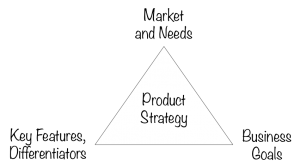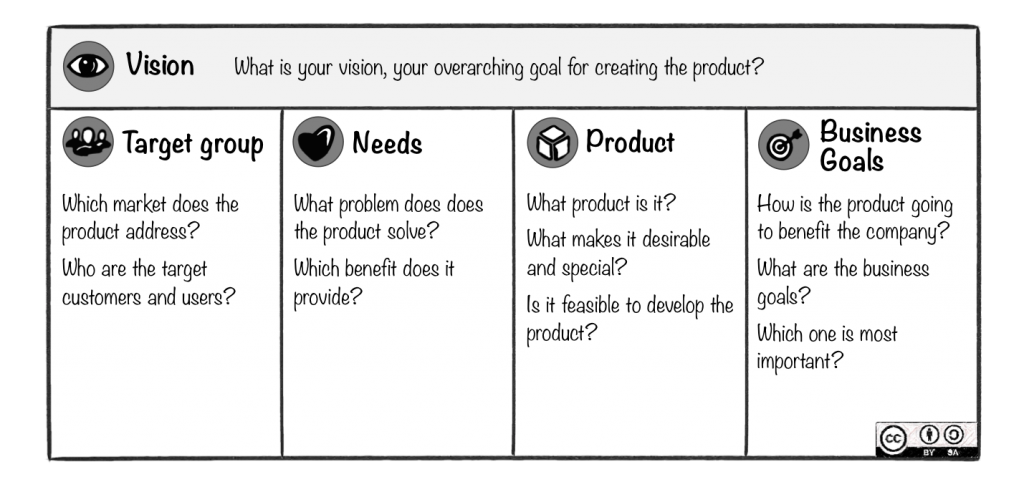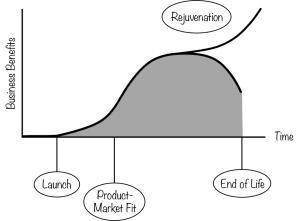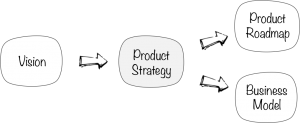The Product Strategy Defined
Summary
Creating a successful product requires attention to the details, from getting the user interaction and the visual design right to providing the right functionality and using the right technologies. With so much focus on the nitty-gritty, it’s easy to no longer see the wood for the trees. This is where the product strategy comes in. It helps you manage your product proactively and it prevents you from getting lost in the details. This post discusses what an effective product strategy is and how it benefits you.
The Three Elements of an Effective Strategy
A product strategy is a high-level plan that helps you realise your vision or overarching goal. It describes who the product is for and why people would want to buy and to use it; what the product is and why it stands out; and what the business goals are and why it is worthwhile for your company to invest in it, as the following picture shows.
The market describes the target customers and users of your product, the people who are likely to buy and to use it. The needs comprise the main problem your product solves or the primary benefit it provides. Think of a product like Google Search or Bing that solves the problem of finding information on the Internet. Compare it to a product like Facebook that allows you to stay in touch with family and friends.
The key features and the differentiators are those aspects of your product that are crucial to address the main problem or create the primary benefit and that make people choose it over competing offers. Don’t create a mini backlog or a wish list. Instead focus on the three to five key aspects that make people buy and use the product. Take, for example, the first iPhone with mobile Internet, iPod-like digital music player, and touch screen as its key features; or the Google Chrome browser with its focus on speed, safety, and simplicity.
The business goals capture how your product is going to benefit your company. Is it going to generate revenue, help sell another product or service, reduce cost, or increase the brand equity? Being clear on the business goals allows you to select the right key performance indicators (KPIs) and to measure your product’s performance. Take the iPhone and the Google Chrome browser mentioned earlier. While the iPhone currently generates the largest portion of Apple’s revenue, the Chrome browser does not earn any money for Google. But it allows the company to control the way people access the Internet and it has reduced Google’s dependency on third-party browsers such as Mozilla’s Firefox and Microsoft’s Internet Explorer. Both are important business benefits.
You can capture your product strategy with the Product Vision Board, a simple yet effective tool shown in the following picture. You can download it from romanpichler.com/tools/vision-board or by clicking on the picture below.
The Product Vision Board above captures the vision at the top. The four sections underneath it describe the strategy. The questions help you provide the right information. You can find more information about the tool in my post “The Product Vision Board”.
Strategy Focus and Inflection Points
The product strategy is not a static, fixed statement or document that you create for a new product. It changes as your product grows and matures. The following picture shows the product lifecycle with four key events: launch, product-market fit, rejuvenation, and end-of-life.
The strategy for a new product should first help you get to launch, then achieve product-market fit (PMF), and finally sustain the growth of your product. Think, for instance, of the changes Apple has made to the iPhone since its launch in 2007 to keep it attractive and preserve its growth, from adding apps to changing the its size. Once the growth starts to stagnate you have reached another strategic inflection point: You either revitalise your product, for instance, by rejuvenating it or taking it to a new market, or you let it mature and eventually decline and die. To use the product strategy to proactively manage your product, you should review and adjust it on a regular basis – I recommend once a quarter as a rule of thumb.
The Product Strategy in Context
If the product strategy describes the key elements required to develop a success product as I suggested above, then where are the vision, the product roadmap, and the business model? The following picture shows how I relate the four artefacts.
I view the vision as the ultimate reason for creating the product that describes the positive change your product should bring about as I describe in more detail in my post “8 Tips for Creating A Compelling Product Vision”. If you think of the strategy as a path to the vision, then the vision guides the strategy. Say I want to create a health app that helps people become aware of what and how much they eat. The vision could be to help people eat healthily, and the strategy might be to create an app that monitors the food intake. But that’s not the only way to attain my vision. If it turns out that the app is not a great idea, I could pivot and write a book on healthy eating, for instance, while still following my vision.
As the picture above shows, I view the product strategy as an input for the product roadmap. The roadmap states how the strategy is implemented and describes how the product is likely to grow. The two work in tandem, as I describe in my article “10 Tips for Creating an Agile Product Roadmap”.
Similarly, I like to derive the business model from the product strategy. A compelling value proposition and a large enough market is at the heart of every business model. It therefore makes sense to get the strategy right before you worry about the marketing and sales channels, the cost of acquisition, electing the right partners and suppliers and other business model aspects.
| Reference: | The Product Strategy Defined from our JCG partner Roman Pichler at the Pichler’s blog blog. |








